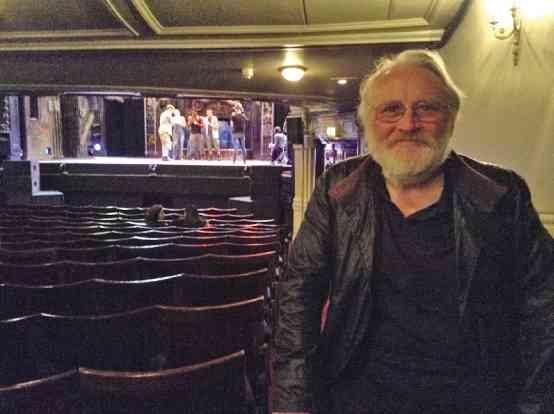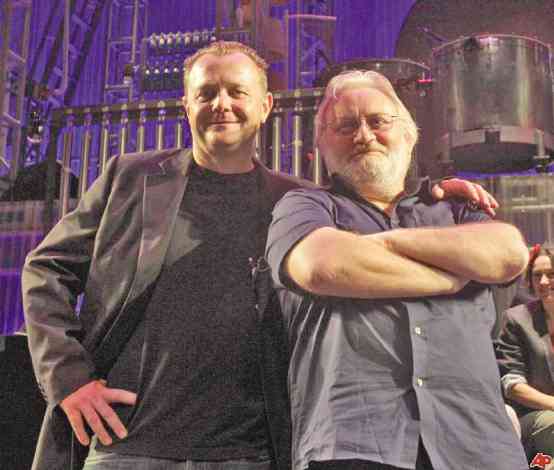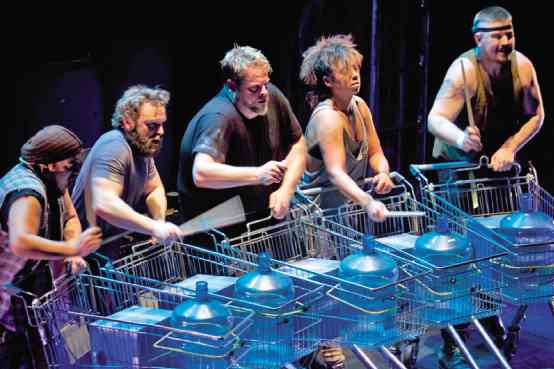A life well-heard
LONDON—Here is a man who listens. Easily three-quarters of his 56 years has been spent in what he believes is the same way that everybody does, detecting “sound patterns and breaks” in everything. All the time.
According to Steve McNicholas, British-born cocreator of “Stomp,” the phenomenal dance percussion act, “Most people just don’t realize it. It’s like watching clouds. Everyone takes away something different, and in varying degrees.” In an earlier interview, he said it was inevitable, really. “Everyone has a built-in sense of rhythm; everyone has a heartbeat.”
Well, this peculiar production has made audiences around the world see that. It’s a good guess that no one walks out of the theater not regarding old pots and pans, brooms, pipes, newspapers and trash cans, with new eyes… and ears. That’s an estimated 20 million people who have watched performances in playhouses and festivals around the world.
Return run
Filipino moviegoers glimpsed “Stomp” a few years back, before they knew of the production. Between main feature screenings, this 30-second trailer heralding the power and crispness of the Dolby sound was shown, of 10 “Stompers” doing their thing, one of them outfitted with large steel drums for footwear. A good many were impressed; some merely amused, probably, but to this day everyone remembers that. (Now we also know that the drum-dragging one was a Pinoy, Andres Fernandez.)
Article continues after this advertisementThree years ago, “Stomp” (which began its theater life in New York City in 1994) was brought to the Philippines for the first time by UK-based Lunchbox Theatrical Productions and Concertus Manila. All eight performances at the Cultural Center of the Philippines were sold out.
Article continues after this advertisementRepeat spectators, as well as new converts, are expected to turn up for the six-day return run, also at the CCP, which starts on Tuesday, June 17.
McNicholas spoke with the Inquirer and a few other Philippine media outlets between “Stomp” rehearsals at the Ambassadors Theatre on West Street here.
Let alone “innovative,” “entrancing,” “exhilarating,” “a banging, smashing, clanging joy”—recurring refrains in critical notices—the act, McNicholas stressed, is kept “funny and playful,” or else its essence is lost.
Both McNicholas and his cocreator/codirector Luke Cresswell staunchly maintain that “Stomp” is all about “connecting with an audience,” a conviction that has propelled their work. In fact, their early lives as artists depended on that connection.

BETWEEN rehearsals at the Ambassadors Theatre, cocreator Steve McNicholas tells the Inquirer his story. EMMIE G. VELARDE
Street entertainers
McNicholas related: “Luke and I were buskers (street entertainers). We used to play at the piazza in Covent Garden (in the fringes of London’s West End), down by the beach in Brighton … at street corners in Paris, in Zurich, Amsterdam… We performed for many years at Edinburgh Arts Festival (Scotland), where we were quite successful and quite popular. We were a band, but we were very theatrical.”
He described the early street gigs: “I played violin and guitar and sang. Luke was the drummer, and he sang a little bit. We would always grab people to participate. Luke had his snare drum belted around his waist and he tapped and played with everything in sight—bicycles, dust bins, even policemen’s hats, once we were sure they were friendly.”
Something quirky
It was just a matter of time before the idea of “Stomp” started rumbling in their heads. McNicholas said, “We wondered, if there was anything more we wanted to see in Edinburgh, what would it be? Certainly something quirky, totally experimental, with a touch of madness.”
They didn’t think that that would appeal to a lot of people. Just the same, “We couldn’t stop plotting; we were doing it for ourselves.”
In 1991, “Stomp” officially made its debut in Edinburgh. Said McNicholas in a 2011 interview, “‘Stomp’ is theater made by musicians. It’s an exploration of rhythm, created solely with familiar household and industrial objects.”
Thus, it began as a festival piece but, Cresswell related in the same interview, “It didn’t do great in Edinburgh, actually! It was put on at midnight, so it actually became a hit with the other performers and critics and not so much with the audience. But [after that, we] were able to go to Australia and did shows at festivals in Sydney, Melbourne and Adelaide.”
Capacity audiences
For three years, the original cast played to capacity audiences around the world, from Hong Kong to Barcelona, from Dublin to Sydney. In January 1994, the touring culminated in a sell-out season at Sadler’s Wells Theatre, for which Cresswell and McNicholas won an Olivier Award for Best Choreography in a West End show. That same year, it was invited to play off-Broadway. Talk about a turning point. Still, “Stomp” took a circuitous route before it finally opened in the West End in 2002, at the Vaudeville Theatre. The Ambassadors Theatre is its current home.
In 2004, New York celebrated 10 years of continuous performances at the Orpheum Theatre by renaming 2nd Avenue at 8th Street… Stomp Avenue.

CREATIVE PARTNERS Luke Cresswell, left, and Steve McNicholas during a special press event at the Adrienne Arsht Center in Miami in September 2010. AP
Today, “Stomp” has five companies performing worldwide.
They had the name “Stomp” before they got the show together. McNicholas volunteered, “Luke told me one day of this idea that he had… a guy sits onstage as the audience walks in, and when the people are settled, the guy then shouts, ‘Stomp!’ Years later, when the show was taking shape, we both knew what it would be called.”
The way McNicholas explains it, being a Stomper is not a forbidding dream. “When we conduct auditions, we just say, ‘If you think you have a sense of rhythm and a sense of humor, come and try out.”
That’s right, a sense of humor. “It’s important that the show doesn’t take itself seriously,” said McNicholas. “It’d be really easy for it to become performance art, or plain indulgent, and we never did want that.”
Fun showdowns
What the creative partners always want to see are performers playing off one another, having little showdowns, “in a funny way.”
McNicholas said, “Our auditions are more like workshops. We’ll have maybe 20 people onstage, we take something from the show, start rhythm exercises and, for the most part, just see how each one works in a group. Because someone may be a great performer, but can’t communicate.”
Series of highlights
In a sparkling series of highlights in the life of “Stomp,” McNicholas singles out the night his troupe performed at the 1996 Academy Awards with an original piece involving the live synchronization of classic film clips and onstage action. Featured were 20 Stompers from all five productions.
McNicholas recalled: “No one had ever done a performance for the Best Sound Effects category before that. And it was a fantastic night because we were nominated for an Oscar that night as well (for ‘Brooms,’ a 15-minute short based on ‘Stomp’s’ opening routine). So I was seated up front.”
(The following year, McNicholas and Cresswell created and directed “Stomp Out Loud,” a 45-minute special for HBO that combined stage material with new pieces made for TV. It was nominated for four Emmy Awards.)
“Stomp” marked its 20th anniversary in November 2011.
McNicholas jested in an interview for the celebrations: “You wonder where 20 years went. In some ways it doesn’t feel like 20 years at all and in other ways it does, because our bones are creaking a bit now.”

AUDITIONS for the show are really workshops, to see how everyone fits in with the group. EMMIE G. VELARDE
Like the old days
The best compliment he received that night was “people from our former lives [as workers] in the alternative cabaret scene in the 1980s” still referring to ‘Stomp’ as ‘that new thing you did.’”
McNicholas and Cresswell took the West End cast to Covent Garden for a 20-minute busk on anniversary day, Nov. 14. “Like the old days, when we first started out,” McNicholas said, “and it was good because none of them had ever performed on the street before. We got a great crowd.”
Another big highlight for McNicholas: “A peak moment in the ‘Stomp’ story, in terms of the audience and the show just working right was in Sadler’s Wells in January 1994. We were there for three weeks and for me that’s when the show and the cast really found strength. To have come from the street and be at Sadler’s Wells, with the place packed…”
(Sadler’s Wells Theatre in London is considered one of Britain’s foremost dance venues and producing houses.)
It’s a small world
“Highlights” for Cresswell had taken on a new meaning by “Stomp’s” 20th anniversary: “Everywhere we’ve been has provided some form of highlight along the way. The fact that you can take this show anywhere—Mexico, Japan—I mean, we played Palestine! We can cross barriers and cultural divides.”
Keeping the act fresh after 20 years, said McNicholas, “is like tending a garden. You watch it constantly and work with the performers. Luke and I are hands-on. We hand-pick everyone and check all the shows.”
“Stomp” will keep going, he said, “as long as we have bums on seats.” That is, to say, “as long as people are enjoying it and as long as we enjoy doing it.”
Cresswell’s most significant learning from the show is that, “The world is much smaller than we thought. We now have friends all around the world. The cast was originally eight British people but now we have Brazilian, French, Swiss, American performers… people of every nationality.”
And Filipinos. “I don’t know why,” McNicholas said. “Filipinos do make great Stompers.”
The Manila show
“The show doesn’t have a story or dialogue” McNicholas noted, “but, it’s true, we’ve found over the years that it transcends cultural and language barriers.”
To think that, in his own words, the sound of “Stomp” has been defined by something as mundane as UK-made dust bins.
“They’re the best kind in the world. The metal is thicker than anywhere else. And they sound different,” explained McNicholas. “I used to think we were keeping the manufacturers alive, shipping containers full of dust bins abroad for our shows. Now they are sold as designer accents.”
For the second Manila run, audiences will get to see at least two new routines: one featuring grocery carts, another involving “frogs.”
McNicholas elaborated, “They’re things we found at the plumbers—flexible tubes used to connect pipes… if you close your eyes, they sound like frogs. We bought a whole range of them.”
He is by no means done with his life’s work. As a kid, McNicholas said, he was “always moving, always tapping.” It must have driven his parents crazy at some point but, he quipped, laughing heartily, “Not as much as Luke drove his mum nuts! I became a violinist, guitarist and singer. Luke is still banging on his drums.”
And McNicholas is still tapping, still listening. “I don’t think I have heard every sound and rhythm there is.”
(“Stomp” in Manila 2014 goes onstage at the Cultural Center of the Philippines Main Theater June 17-22, 2014; Tuesday to Friday, 8 p.m.; Saturday and Sunday, 2:30 p.m. and 7:30 p.m. Call TicketWorld, 8919999.)

